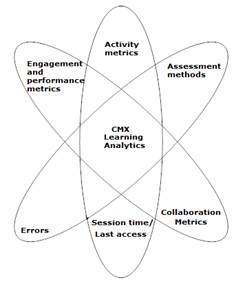The emergence and gradual use of educational games seems to be an exceptional means to motivate students in participating more actively in the learning process, since the majority is already familiarized with the game’s graphical environments and find their scenarios entertaining.
However, although educational games are an interesting tool that could be used, a significant challenge to be addressed is the identification of all the ways progress and results can be measured for examination. This way, we can determine how effectively the initial educational goals are fulfilled and which activities depict students’ performances. This can be carried out with the incorporation of Learning Analytics (LA) in Game Based Learning, a process we refer to as Game-Based Learning Analytics (GBLA).
CMX Implementation
The LA theory was taken into consideration during the design phase of the educational game. More specifically, we aimed from the beginning that the game would retrieve appropriate feedback from teachers and students and would be able to assess whether the educational goals were met. This way, teachers could reconfigure the game if results showed that the progress of students was not successful. Thus, we have defined six main pillars as axes that comprise the basic LA concepts taken into consideration in CMX. The figure presents the proposed framework, which consists of six axes, where the two ends of each axis include inter-related concepts.

To implement the framework, we created a mathematical model that will automate the process of gathering results and drawing conclusions with the help of LA. This model includes the usage of an algorithm that measures and grades the players’ behaviour, i.e. the value changes of the varying factors that we are examining for each player as they are being stored in the system’s database. This activity’s value is stored as a vector and transferred in the database as shown below:

CS is the indicator of the score that suggests the client-server message transmission, while t is the time parameter, since the values that these variables take change through time. The GCS (Grade) is a vector that corresponds to each player and indicates the educational score the player gets in the game’s progression. This score is dependant on a) the player’s success percentage during the assessments (variable SCS), b) how many errors the player made (ECS), c) how active the player is (ACS), d) how frequently the player visits the game (FCS), and finally e) how collaborative the player is (CCS). We define the values of the ideal behaviour as S0, E0, A0, F0, C0, while n is the number of transactions per player. Finally, a transaction is considered the completion of a task within a game level.